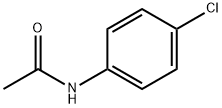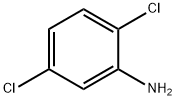4-Chloroaniline , 98% , 106-47-8
Synonym(s):
4-Chloroaniline;p-Chloroaniline
CAS NO.:106-47-8
Empirical Formula: C6H6ClN
Molecular Weight: 127.57
MDL number: MFCD00007835
EINECS: 203-401-0
PRODUCT Properties
| Melting point: | 67-70 °C (lit.) |
| Boiling point: | 232 °C (lit.) |
| bulk density | 790kg/m3 |
| Density | 1,43 g/cm3 |
| vapor density | 4.4 (vs air) |
| vapor pressure | 0.15 mm Hg ( 25 °C) |
| refractive index | 1.5546 |
| Flash point: | 120°C |
| storage temp. | Store below +30°C. |
| solubility | 2.2g/l |
| form | Crystalline Solid |
| pka | 4.15(at 25℃) |
| color | Beige to brown-purple |
| Specific Gravity | 1.2417 |
| Odor | Sweetish |
| PH Range | 6.9 at 1.00000 g/l at 20 °C |
| PH | 6.9 (1g/l, H2O, 20℃) |
| Water Solubility | 0.3 g/100 mL (20 ºC) |
| Merck | 14,2118 |
| BRN | 471359 |
| Henry's Law Constant | 1.07 at 25 °C (calculated, Howard, 1989)(x 10-5 atm?m3/mol) |
| Stability: | Stable. Combustible. Incompatible with strong oxidizing agents, acids, acid chlorides, acid anhydrides, chloroformates, nitrous acid. May be light sensitive. |
| LogP | 1.83 at 25℃ |
| CAS DataBase Reference | 106-47-8(CAS DataBase Reference) |
| IARC | 2B (Vol. 57) 1993 |
| NIST Chemistry Reference | p-Chloroaniline(106-47-8) |
| EPA Substance Registry System | p-Chloroaniline (106-47-8) |
Description and Uses
p-Chloroaniline, 1-amino-4- chlorobenzene,is a white to light amber, crystalline solid at room temperature. It is used as an intermediate for pesticides, pharmaceuticals, pigments, and dyes. Production is similar to that of m-chloroaniline .
4-Chloroaniline is an important raw material in production of agricultural chemicals, azo dyes and pigments, cosmetics, and pharmaceutical products. It is used as an intermediate in the manufacture of chromophore AS-LB, as well as in pharmaceutical intermediates such as chlordiazepoxide and phena tincture. It is also an intermediate for the herbicide Anilofos, the insecticide chlorbenzuron and the plant growth regulator Inabenfide.
Safety
| Symbol(GHS) |    GHS06,GHS08,GHS09 |
| Signal word | Danger |
| Hazard statements | H301+H311+H331-H317-H350-H410 |
| Precautionary statements | P201-P280-P301+P330+P331+P310-P302+P352+P312-P304+P340+P311-P308+P313 |
| Hazard Codes | T,N,F |
| Risk Statements | 45-23/24/25-43-50/53-52/53-39/23/24/25-11-51/53 |
| Safety Statements | 53-45-60-61-36/37-16-7 |
| RIDADR | UN 2018 6.1/PG 2 |
| WGK Germany | 3 |
| RTECS | BX0700000 |
| F | 8-10-23 |
| Autoignition Temperature | 685 °C |
| Hazard Note | Toxic/Possible Carcinogen |
| TSCA | Yes |
| HazardClass | 6.1 |
| PackingGroup | II |
| HS Code | 29214210 |
| Hazardous Substances Data | 106-47-8(Hazardous Substances Data) |
| Toxicity | LD50 orally in rats: 0.31 g/kg (Smyth) |



